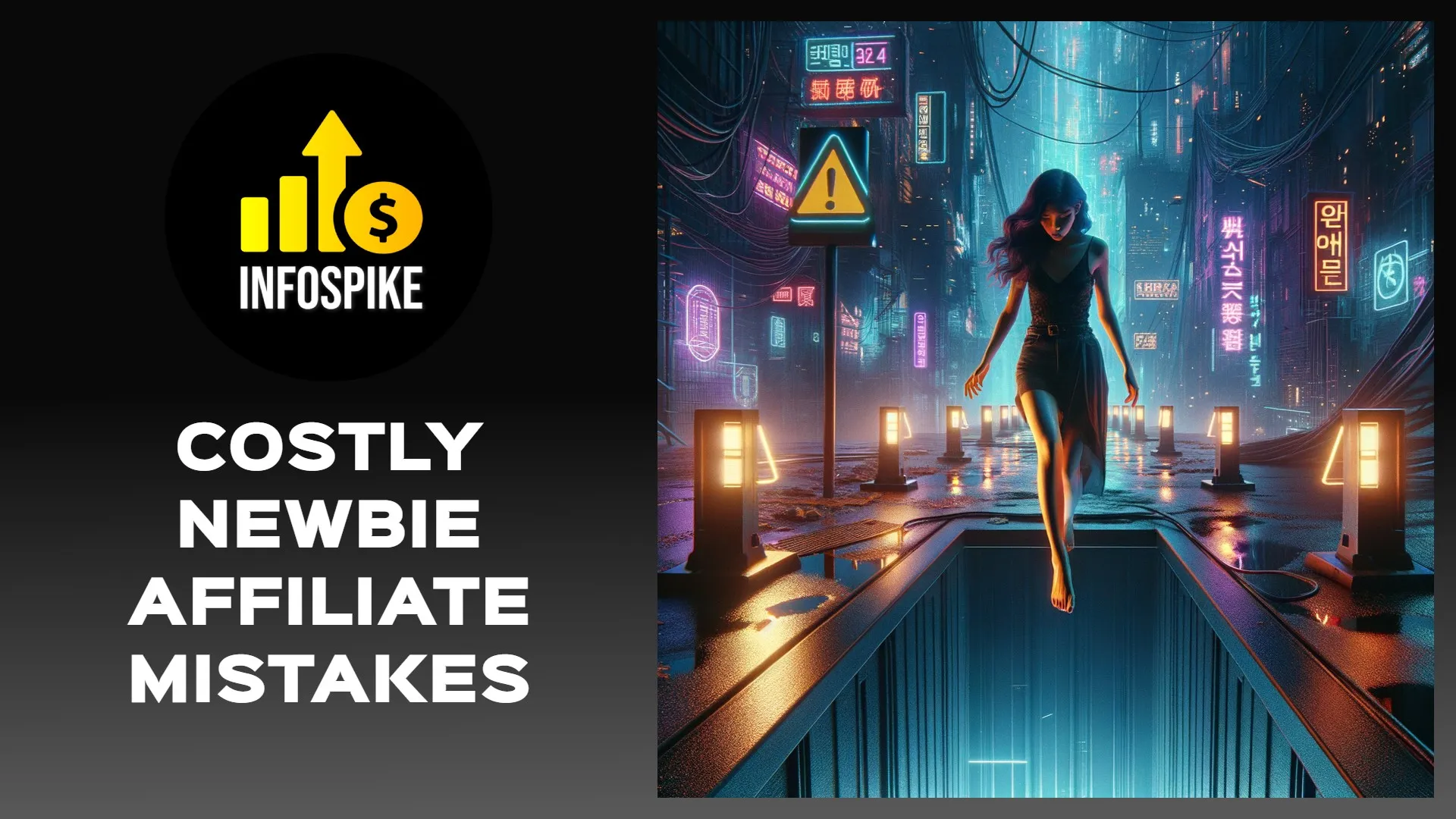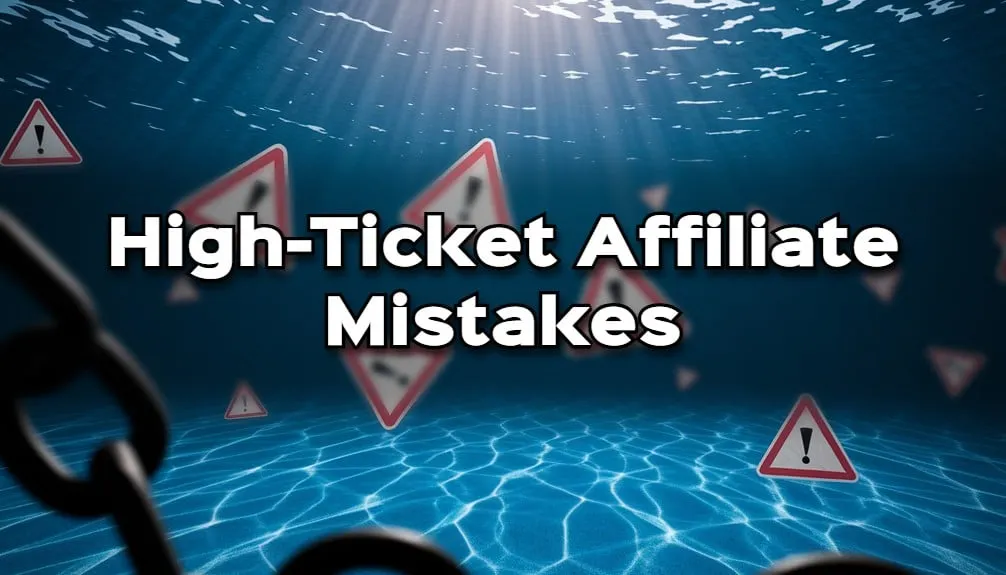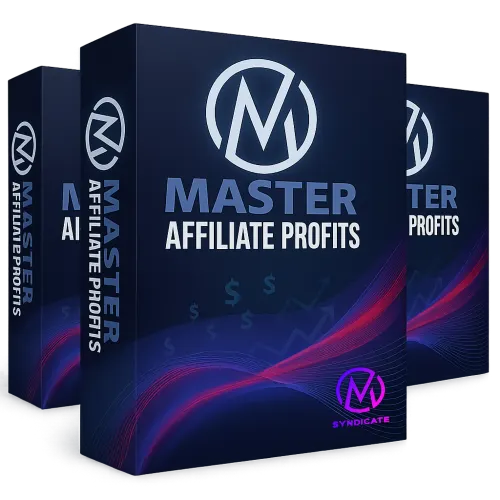14 Costly Mistakes New Affiliate Marketers Must Avoid
Have you ever felt that spark of excitement when discovering the potential of affiliate marketing? Visions of earning an income online from anywhere in the world, setting your own schedule, and having the freedom to live life on your terms dance through your head.

As a new affiliate marketer, that enthusiasm and optimism is fantastic - but it can also lead to costly mistakes if you’re not careful. Avoiding pitfalls will accelerate your path to success in affiliate marketing.
So what should you watch out for? Here are the top 14 mistakes new affiliate marketers must avoid to maximize results and minimize frustration:
Picking the Wrong Niche and Affiliate Programs
The foundation of any affiliate marketing strategy is choosing what niche and programs to promote. Get this decision wrong out the gates, and you’ll struggle to gain traction.
Choosing a niche you have no interest or experience in
Some niches simply generate more affiliate income potential than others. But chasing money alone without passion or expertise to back it up causes issues down the road.
Picking a niche just because it looks financially lucrative on paper ignores the reality of sustaining consistent effort in an area you don’t genuinely care about or understand.
Lack of interest or experience in your niche makes creating compelling content far more difficult. Why spend long hours working in an area that drains you rather than energizes you?
Sure the niche has money-making potential - but if you don’t have knowledge or enthusiasm for the subject matter, earnings will stall once the initial excitement wears off.
It’s critical to choose a niche you find interesting and already have some existing knowledge in. If you enjoy gaming for example, promoting gaming related affiliate programs makes maintaining motivation and producing content so much easier.
The freedom and income of affiliate marketing shines brightest when you merge passion with opportunity.
Joining too many programs at once as a beginner
With so many great affiliate programs available, it’s tempting as a new marketer to join them all right away. But hold your horses!
Juggling several programs simultaneously can quickly become overwhelming. When starting out, resist the urge to have your hands in too many cookie jars.
Mastering even one or two affiliate programs at first is far more profitable long-term than fracturing your focus across a dozen different options.
Once you develop skills and traction in a smaller subset of programs, you can gradually expand your roster over time. But jumping into the deep end too quickly may just cause you to drown.
Selecting programs with low commissions and untrustworthy companies
Not all affiliate programs are created equal in terms of commission rates and company reputation.
Some programs offer just 5-10% commission rates, while others provide anywhere from 20-75% commissions on each sale you drive. Even a few percent difference has a major compounding effect on income over hundreds or thousands of sales.
Research each program’s commission structure and payout timing. Monthly recurring commissions from a 20% share can quickly surpass a higher 50% one-time payout.
Company reputation also matters greatly. Promoting shady or unreliable brands dents your own credibility with your audience. Seek out programs from reputable companies that pay reliably and on time.
Checking affiliate program reviews on authoritive sites provides transparent insight into a program’s real commission rates and reputation. Leverage these reviews to find programs that reward you handsomely for results.
Picking profitable niches and vetted affiliate programs sets the stage for growth as a new affiliate marketer. Do your homework here before proceeding further.
Neglecting Website and Content Development
The core of affiliate marketing revolves around promoting affiliate links by creating valuable content. Too often, new marketers put the proverbial cart before the horse - focusing on links before establishing any content distribution channels.
This leads to substantial missed opportunities. Don’t take your website and content creation duties lightly.
Not having a website to promote affiliate programs
Imagine a brick-and-mortar business without a storefront location. How could they attract customers off the street?
Your website serves as this digital storefront in affiliate marketing, centralizing all your promotions in one platform.
Without this hub, you’re forced to rely on dispersed social media posts and emails alone. While these work as supplementary channels, they can’t replace your website's authority and visibility.
Invest in building a website to showcase your niche content and affiliate links. It also demonstrates your commitment to a long-term business rather than chasing quick bucks through shady means.
Even a simple Wordpress site gets the job done when starting out. You can evolve the site over time as your audience and income grows.
Failing to regularly publish valuable content for your niche
Simply having a website isn’t enough. You need to continually create and publish fresh content for your target audience.
Content is the fuel powering your affiliate promotional activities. It builds authority and organic traffic that you can then convert into sales.
Make content creation a habit by setting a consistent publishing schedule. As an affiliate, your website landscape quickly becomes barren without a steady stream of new material.
Stay vigilant in providing value to your niche audience through blog posts, videos, and other content on topics they care about. This content indirectly promotes your affiliate links down the road.
Copying others' content instead of creating original value
When lacking inspiration for new content, some affiliates resort to copying and repackaging existing content from around the web rather than developing original value.
On the surface this seems like an easy shortcut to generate more content quickly. But in reality, it only damages your authority and credibility when caught.
Search engines heavily penalize duplicate content and scraped articles. Even if you avoid automated detection, your readers recognize when they find rehashed material elsewhere. This quickly erodes trust.
Creating and curating your own unique content aligned with your brand voice is far more effective for establishing expertise. Support your audience with fresh perspectives and actionable advice.
Bite the bullet on content creation now rather than jeopardizing your affiliate marketing foundation through shortcuts. Original high-value content earns attention and loyalty - copied fragments do not.
Not Building an Email List
Beyond just attracting an audience to consume your website content, savvy affiliates also build an email list for direct subscriber communication.
This list provides immense marketing leverage through the ability to promote to subscribers directly via email. But many affiliates completely overlook list building in their strategy.
Don’t make this costly oversight if you want to maximize earnings!
Importance of email marketing for affiliate promotions
Email still reigns supreme as the most direct and high-converting digital marketing channel.
Your website and social media channels reach a broad audience - but not everyone visiting converts right away. Recording email opt-ins allows you to follow up and continue nurturing leads.
Through email sequencing, you can promote your affiliate offers and content to subscribers who already expressed interest through opting in. This targeted re-engagement dramatically boosts conversions.
Email also facilitates promotions to your most engaged audience. Website visitors often consume content just once, whereas email subscribers constantly receive your affiliate links and offers through your sequences.
The income potential through email simply eclipses other channels. Make list building core to your affiliate approach from day one to see dramatic results.
Lead magnets and giveaways to grow your email subscribers
Of course, a list is worthless if no one opts in! Simply showing subscription forms on your site achieves minimal conversions.
Instead, utilize lead magnets and giveaways to incentivize visitors to subscribe in exchange for delivering them valuable free content.
For example, an ebook, video course, or resource list given in exchange for their email gets way more sign-ups than asking alone.
Structure your lead magnets around hot topics that complement your affiliate niche and programs. A lead magnet focused on social media marketing for example can promote your Facebook advertising affiliate links within the content.
Just ensure your lead magnet provides legitimate value rather than solely promoting affiliate offers. Find a fair value exchange to catalyze list growth.
Email sequence automation for sales funnel
Manually sending one-off emails does not maximize potential either. The key is automating sequenced emails to subscribers over time.
Immediately after a visitor opts in, they receive a preset “welcome” email outlining the value promised and linking to the lead magnet. This kicks off the relationship positively.
From there, funnel them through a series of “onboarding” emails providing helpful advice and recommendations within your niche. Naturally integrate affiliate links where relevant.
Promote affiliate offers directly through dedicated emails in your sequence. Test timing and messaging for optimal results.
Setting this sequence up through email services like Mailchimp or ConvertKit allows you to “set it and forget it” for passive income generation.
Email marketing forms the cornerstone of an affiliate marketing business. Build your list immediately, create value-driven lead magnets, and automate onboarding sequences to skyrocket conversions from your audience.
Avoiding Social Media Marketing
While email marketing should form the core of your affiliate strategy, avoiding social media completely squanders major promotional possibilities.
Each major social media platform offers unique opportunities to connect with your niche audience and spread your affiliate links. Do not ignore them!
Establishing authority and reach through social platforms
Every social media site allows you to create a distinct brand profile centralizing your affiliate content and links.
Leveraging these built-in platforms to grow an audience around your niche establishes critical authority and reach.
For example, building a YouTube following with affiliate link-including videos lets you tap into the platform’s two billion monthly users. The same goes for Instagram, Facebook, Twitter and other networks.
Publishing valuable material on these networks diversifies your traffic sources. This expands your pool of potential customers who may convert through your affiliate links.
The more quality content you create on multiple platforms, the faster your social media reach and affiliate influence grows.
Tailoring content for each major network
While promoting your affiliate brand across multiple networks is advised, the content itself shouldn’t be identically recycled.
Each social site has a distinct user base and optimized content formats. Tailor your posts and strategy to fit each one.
For example, Instagram leans heavily towards viral visual posts, whereas Twitter rewards concise textual commentary. Facebook welcomes lengthy educational articles and videos.
Identify what engages each platform’s users, then craft your affiliate content accordingly. Don’t try to blanket spam each network with the same material.
Speaking to the particular users, algorithms, trends and formats of each social platform through tailored content yields the best response and conversions.
Utilizing paid social ads to supplement organic efforts
Once you’ve built an initial audience, paid social ads provide a powerful supplement to expand your organic reach further.
Tools like Facebook and Instagram ads give incredible targeting flexibility. You can zero in on potential customers most likely to convert based on their interests, demographics and behavior on the platform.
Paid ads also help you test messaging variations and analyze performance through clear metrics like cost per click and conversion tracking.
Starting with just a small daily paid ad budget to complement your organic social efforts can drive big returns. The testing and optimization data you gain also improves your overall affiliate approach.
With over 3.7 billion global social media users today, ignoring these platforms cripples your affiliate income potential. Tailor your participation and paid ad campaigns for each to maximize results.
Overlooking the Importance of SEO
Have you properly optimized your affiliate content for search engine visibility? Surprisingly, many new marketers minimize or completely ignore critical search engine optimization (SEO).
This limits the discoverability of their affiliate content and sites in Google rankings, starving organic traffic and conversions. Prioritize essential on-page and off-page SEO as an affiliate.
Search ranking for organic traffic and conversions
Google sends over 63,000 searches per second from people seeking information. Targeting these high-intent searchers through SEO represents a huge income source.
But you only tap into this demand if your content ranks on page one for relevant affiliate keywords. Few search further than the first page.
Optimizing pages for target keywords through strong technical SEO and backlink building is the only way to consistently gain exposure from search traffic.
Once on page one, this converts to lead and sales pipeline 24/7 by showcasing your affiliate links or content to engaged searchers. SEO success is critical for scalability.
On-page optimization best practices
Start with fundamental on-page optimization to boost search visibility.
If you're doing SEO for YouTUbe, most of this won't apply (which makes ranking simpler).
- Include primary and secondary keywords in page titles and H2 tags
- Feature keywords naturally in page content and URL
- Use keyword-rich image names, alt text and captions
- Optimize page load speed through size reduction
- Ensure proper use of headings, lists, bold, etc
- Provide an XML sitemap and optimize it for search
These on-page factors form the basis of strong technical SEO. Complete them first before moving to off-page efforts.
Link building and keyword strategies
Next, build high-quality external links from other sites back to your affiliate content using white hat techniques.
Secure editorial links from relevant niche sites through outreach and guest posts. Publish and promote content assets that other publishers want to link to as well.
Distribute your content across different domains while anchoring links with keyword-rich anchor text. Focus on sustaining a diverse, growing domain link profile month after month.
Smart SEO optimized around your affiliate niche keywords earns long-term organic traffic and conversions. Make this a priority immediately to tap into search demand.
Not Tracking Conversions
How do you know which affiliate campaigns and links actually generate results if you don’t track conversions? Shockingly, many new marketers fail to implement adequate tracking.
This makes assessing performance and ROI virtually impossible. You end up flying blind, unable to identify your successes. Proper tracking is non-negotiable.
Analytics for quantifying traffic, leads and sales
In-depth analytics allow you to measure which links earn clicks, leads, and ultimately sales or commissions.
Platforms like Google Analytics and Facebook Pixel provide visibility on customer behavior and conversions on your site. They unlock actionable data to refine your efforts.
For example, you can identify your highest traffic and converting landing pages then optimize them further. Or determine which affiliate links deliver the most email subscribers so you can promote them more heavily.
Making data-driven decisions separates thriving affiliates from those guessing in the dark. The metrics don’t lie - accurate tracking reveals paths to maximum commissions.
Trackable affiliate links and attribution modeling
Beyond general site analytics, you need visibility on individual affiliate link performance. URL shorteners like bit.ly allow you to create trackable links.
Shortening your affiliate links through them or directly within affiliate programs lets you identify exactly which assets drive actions.
These shortened links also allow attribution modeling. For example, you can track a user that clicked your Facebook ad, landing page, then converted through your email sequence.
When you know exactly how your funnel steers customers from initial click down to final conversion, you gain immense insight on how to scale up success.
Identifying top converting campaigns
Compiling all your tracking data reveals winning patterns - your highest converting offers, pages, creatives, channels and more.
Zero in on what works and cut what doesn’t. Tracking provides the missing layer of insight that new marketers lack.
For example, you may discover Instagram earns minimal conversions for you compared to SEO traffic and email. You can shift focus to double down on what generates sales.
Use tracking to guide your testing and iteration. Over time it leads you to campaigns, assets and funnels that convert like clockwork.
Make analytics your compass, keeping your affiliate marketing pointed firmly in the direction of maximum commissions at all times.
Abusing Affiliate Links
Balancing promotion with value is an artform in affiliate marketing. Including too many links too often erodes audience trust quickly.
Many new affiliates make the mistake of aggressively pushing links rather than providing helpful information first. This backfires badly.
Avoiding pushy overpromotion of links
Imagine opening an email from a company you admire, only to find it dominated by sale banners and product links from top to bottom. Deflating, right?
Similarly, affiliate links lose their power when overplayed from the start without offering value upfront. Coming off salesy damages your relationship.
Lead instead with helpful advice, recommendations and resources for your audience centered around solving their problems. Links should naturally fit where useful.
Gently nurture visitors through an affiliate funnel, not squeeze them from the first interaction. Prioritize value creation above all else initially to build engagement.
Providing value first, links second approach
Think of your content’s link inclusion as a rising curve - sparse early when establishing know-like-trust, increasing steadily when contextually relevant.
Rushing affiliate links prematurely trains your audience to ignore or distrust them. But introducing them gradually when truly useful earns clicks.
The internet is flooded with low-value content simply optimized to rank and sell. Break this pattern by crafting posts that first inform and engage, then promote appropriately.
This earns attention now while positioning you as a trusted resource worth returning to. Customer loyalty compounds over time.
Cloaking links to improve CTR
When you do include affiliate links, “cloaking” them boosts clicks and conversions versus raw untransformed URLs.
For example, build context with anchor text like “This BlueHost guide helps you start a Wordpress blog from scratch”. The domain itself is hidden behind context vs dumping naked URLs like “https://infospike.com/map”.
Anchor text framing grabs reader interest better.
Cloaking also shortens ugly long links into clean redirects as covered earlier. Just avoid keyword stuffing anchor text. Provide legitimate context.
Get the balance right on affiliate links to maximize income. Avoid shoving links without value upfront, and cloak them in compelling context to boost performance.
Ignoring Mobile Optimization
With over 63% of website traffic now originating on mobile devices, failing to optimize erodes your potential affiliate promotions and sales.
Is your website fully mobile responsive? Do your ads and creatives display seamlessly on all devices? Mobile can never be an afterthought.
Majority of traffic on mobile devices
The widespread consumer shift to smartphones and tablets is indisputable at this point. Mobile has overtaken desktop.
Your website layout and content must therefore be flexible to adapt on-the-fly for all screens and browsers. This ensures proper display and easy reading no matter how visitors access your site.
A responsive mobile experience also helps your SEO rankings, since Google favors sites properly built for mobile users. There’s no reason not to optimize.
Responsive design, AMP pages and mobile ads
Use responsive design principles with CSS media queries to build a site that fluidly resizes down for mobile. Test it on all devices to catch bugs.
Also implement accelerated mobile pages (AMP) to speed up load times on mobile. Slow sites get abandoned, costing you conversions.
For paid ads, create dedicated mobile creatives and landing pages. Horizontal video and image formats tend to perform best on mobile feeds.
Refine your paid targeting and bidding to focus on mobile users specifically. iOS vs Android placement often warrants split testing too.
Frictionless user experience on mobile
Always evaluate the full customer journey and confirm no hiccups exist on mobile that could obstruct conversions.
Site navigation should be clear and simple without clutter. Check forms and buttons for fat finger problems. Minimize required scrolling and typing.
Test your mobile checkout and payment processes end-to-end. Any friction here cripples mobile commerce and affiliate sales potential.
With the majority of traffic going mobile, optimizing responsively gives your affiliate promotions the best visibility and seamless user experience on the devices that matter most.
Lack of Follow-Up and Engagement
You’ve attracted an audience and promoted affiliate products - but doing so again to the same people requires ongoing engagement.
Constant customer communication and re-engagement is the lifeline of affiliate marketing. Neglect this stage and your momentum stalls quickly.
Building relationships, not just making sales
Avoid treating customers and email subscribers like one-time conversion targets. To sustain income, shift to building authentic relationships and loyalty.
Check in regularly with helpful or entertaining content that continues bringing value. Surprise giveaways and limited deals raise engagement too.
Growth requires a community mindset where you discuss affiliate offers within the context of serving your audience long-term rather than single quick paydays.
When your followers feel respected and rewarded for their time, they become powerful brand evangelists. This speeds up expansion.
Email, social media and retargeting for engagement
Schedule promotional emails to give previous customers new reasons to return and buy again. Segment contacts by past purchase behavior to personalize messaging.
Promote affiliate content across your social media channels to keep delivering value to those who followed you there as well. Turn them into repeat customers.
Retarget visitors who left your site via ads across the web reminding them to complete their purchase. Pull them back into your funnel.
Providing ongoing value to leads
The more you nurture relationships over time through consistent value, the higher your chances of re-engaging past leads and customers for new affiliate sales.
When you take the long view on delivering value, your authority solidifies, referral opportunities arise, and income compounds. But it takes patient nurturing, not a quick cash grab.
Recurring commissions rewarding you for long-term audience development beats temporary gains from fleeting promotions. Keep providing value, and the revenue will stick around.
No Clear Sales Funnel Process
Do your affiliate marketing activities follow a structured sequence that moves visitors through an intentional conversion funnel? Surprisingly, many beginners have no funnel blueprint at all.
Without a defined multi-stage conversion process to follow, you end up with scattered efforts rather than a cohesive affiliate marketing machine. Map out your marketing funnel.
Multi-stage funnel from awareness to conversion
The most effective customer journeys transition contacts smoothly through multiple stages toward a conversion.
For example:
Awareness > Interest > Consideration > Conversion
This could start with an ad driving them to your opt-in page and receiving your lead magnet. Several onboarding emails follow that nurture them as a lead. A promotional email or retargeted ad leads them to purchase through your affiliate link.
Breaking down your funnel into smaller phases makes execution and optimization easier. Evaluate which stages underperform then improve them to lift overall conversions.
Lead magnets, free content, email sequencing
Populate your funnel with lead magnets, free content offers and email sequences tailored to guide customers through each stage.
For example, early stage lead magnets attract and capture contacts. Further in, a free course or webinar keeps them engaged as a lead. Discount emails motivate conversions.
Mapping out content and messaging at each funnel stage significantly raises conversions compared to a scattered approach. Funnel momentum snowballs when designed intentionally.
Understanding customer journey
Within your structured affiliate marketing funnel, dive deeper into the user experience at each phase.
Analyze the exact journey a customer takes from initial contact through final conversion. Optimize each micro-step to reduce friction.
For example, how easy is it for a visitor to find and complete your lead gen form? How clearly does the confirmation email outline accessing their promised lead magnet?
Smooth user flow through the entire process translates to higher conversion rates. Map and refine this customer experience through ongoing testing.
With a defined, segmented funnel guiding traffic through structured conversion phases, your affiliate marketing gains direction and repeatable processes to scale.
Not Reinvesting Profits
A common affiliate marketing mistake is stopping after earners initial affiliate income rather than reinvesting to spur faster growth.
Preserve some earnings for necessities of course. But plowing profits back into your business accelerates expansion and unlocks bigger passive potential.
Reinvesting affiliate earnings to compound growth
Think long-term with your affiliate marketing business. Reinvesting incomeearned fuels bigger future returns through compounding.
For example, you could spend earnings on purchasing more content assets like blogs or social media pages related to your niche. This expands your audience reach and promotions.
Or invest in paid advertising campaigns, SEO, email list acquisition, outsourcing, and coaching to multiply your promotions.
The more volume and resources you can reinvest, the faster your affiliate income compounds upward through increased conversions and exposure.
Paid traffic, outsourcing, and coaching
Paid traffic like Google and Facebook ads are particularly lucrative to scale up fast when starting out.
Testing and optimizing paid campaigns has a positive ROI when aligned with your proven affiliate funnels. You get guaranteed visibility and leads immediately to recoup ad spend.
Outsourcing repetitive tasks to contractors also allows focusing your energy on high-value priorities with the biggest income impact.
Coaching and courses level up your affiliate skills exponentially faster than trying to learn solo through trial and error. Invest in your expertise.
Avoiding complacency after initial success
After enjoying your first taste of affiliate earnings, it’s tempting to coast and collect checks. Resist complacency.
The most lucrative opportunities come from continually raising the bar and reinvesting to grow beyond your previous limits. Growth stalls when you stand still.
Reinject earnings to propel your business forward. Play the long game, compounding affiliate income exponentially over months and years. Think scale.
Getting Distracted From Goals
With so many potential activities and strategies in affiliate marketing, lack of focus severely limits income growth.
Distractions waste your time and prevent consistency. Stay centered on your core goals and high priority tasks.
Staying consistent despite obstacles and distractions
Affiliate marketing is a marathon, not a sprint. Consistency over months and years creates breakthroughs, not temporary sprints.
But distractions knock you off course and drain consistency. Email notifications, “urgent” flags from others, and tangential tasks derail progress when you lack discipline.
Concentrate and protect time on the 20% of activities driving 80% of your affiliate results. Consistently chip away at these rather than getting sidetracked.
Not comparing yourself to others
Seeing others seemingly skyrocket overnight can also break your focus by inducing pressure and impatience.
But you have no idea the years of work preceding their “overnight success.” Everyone’s path is unique. Stay focused on yours.
Measure yourself against your own previous results rather than others. Are you incrementally improving your skills and income? Comparison kills consistency.
Tracking and celebrating small milestones
Measure progress through daily and weekly milestones to maintain motivation. Acknowledge every small win.
For example, recognize hitting a new blog traffic record, email subscriber goal, or commission earned. These micro-wins fuel consistency.
Outline and track the weekly habits and tasks central to your goals. Check them off to quantify achievement. Consistency compounds.
Shut out distractions and stay laser focused on the tasks most aligned with your big picture affiliate marketing goals. Small daily progress pays huge dividends long-term.
Trying to Take Shortcuts
Affiliate marketing rewards long hours spending time creating value, not hacking overnight systems. Let go of chasing shortcuts.
Building a sustainable and profitable affiliate business takes months and years of consistent effort. But the work ethic pays off exponentially.
No "get rich quick" method as an affiliate
Countless tales of quick riches lure people into affiliate marketing for fast cash. But these false promises lead only to burnout and failure.
Dreams of copying some tactic or having an epiphany that showers you in commissions overnight simply don’t pan out. There are no shortcuts.
Realize affiliate marketing is a skill and career like any other. You get out what you put in. Be wary of any “get rich quick” promises.
Focusing on long-term, sustainable growth
The hours invested in honing your abilities, testing strategies, and crafting funnel assets directly determine your income trajectory, not shortcuts.
Consistently expand your knowledge, create more value and broaden exposure over time. These long-term habits drive sustainable affiliate growth.
Quick fixes and schemes may bring temporary revenue bursts, but they never last. There are no long-term substitutes for skill development and hard work.
Committing time and effort to see results
No matter what strategies or tools you use, affiliate marketing demands extensive time trying, tweaking, and learning from mistakes before it clicks.
Let go of trying to min-max effort for the fastest possible returns. Instead accept that worthwhile skills require deep commitment over years.
Focus on enjoying the affiliate marketing journey, not just the destination. Consistent time and effort inevitably produces results if you stick it out.
Trust that dedicating yourself to mastering the fundamentals over the long-haul leads to the affiliate breakthroughs you seek. Stay patient and committed while avoiding shortcuts.
Fear of Failure and Not Starting
The final affiliate marketing mistake that limits potential earnings is procrastination due to fear of failure or uncertainty.
You must take action before results can materialize. Conquer doubts, start now, and learn from mistakes.
Taking action despite uncertainty
Overthinking breeding fear of the unknown prevents many aspiring affiliates from ever starting. Take the first step.
Understand that uncertainty and unknowns are part of any new endeavor. But avoiding action due to doubt guarantees you zero progress.
Launch something - anything - to just get started and gain momentum. Perfectionism kills action. Embrace imperfection to get moving.
Gaining experience through failures
Next, accept occasional failure as an unavoidable part of progress when trying new strategies and tactics.
All successful affiliates failed their way to those wins. But they learned from mistakes rather than dwell on them. Celebrate failures as progress.
Think scientifically. Each failure brings new data to tweak your approach. Over time, repeated failures compound lessons that create breakthroughs.
Learning from mistakes to improve
The key is not avoiding or reacting emotionally to failures. Analyze them calmly and learn how to improve.
Maybe a paid ad strategy flopped. But review the data on why and pivot your targeting or creative. Try again incorporating lessons learned.
Incremental failure inspires innovation and creativity. Let go of perfection, start taking action now, and embrace failures as progress.
The only true failure is halting your affiliate efforts due to fear of uncertainty or mistakes. Power through self-doubt, stay active, and never stop learning. Achieving freedom through affiliate marketing is worth it!








